Last Updated: July 21, 2025
Costa Rica has nearly 30 national parks, but if you’re a wildlife enthusiast, there’s one that stands out against all the rest. Tortuguero National Park, located in the northeastern-most part of the country, is brimming with exotic birds and animals. Along the zigzagging canals, land trails, and beach, you’ll find everything from monkeys and turtles to caiman and wading birds. There are several ways to explore Tortuguero National Park. In this guide, we’ll share the different options and give some tips so that you see the most.
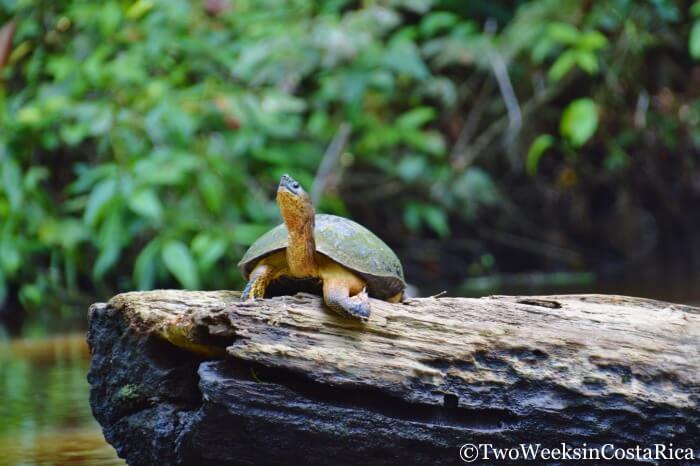
Park Setup
Tortuguero National Park is a vast protected area of land, water, and mangrove in the remote village of Tortuguero on Costa Rica’s Caribbean coast. Because this area is extremely swampy, it is accessible only by boat or small plane. Plan on spending at least a couple of days in the village if you want to visit the park.
For lots more information about visiting Tortuguero, read our post Tortuguero: Wildlife and Culture on the Caribbean Coast.
There are three main ways to explore Tortuguero National Park.
Canals
Probably the most popular way to see the park is on a boat tour through the canals. If you’re staying at one of the resorts, your hotel may include this kind of tour in your package. These hotels typically have their own boats, which are larger (holding around 10-15 passengers) and have a motor.
We did a canal tour through our hotel when we stayed at Tortuga Lodge (an upscale lodge outside town), and it was a wonderful experience. The small boat was completely open on the top, allowing us to see so much wildlife and appreciate the grandeur of the rainforest. Read more about our canal experience.
For those staying in the village at one of the smaller hotels, you can easily arrange a tour through a local operator in town for around $30-45 per person.
The benefit of going through one of the smaller companies is that they take you in a canoe or kayak. These have a silent electric motor or in some cases are hand-paddled. This allows them to go into the narrower offshoots off the four main canals that the larger boats can’t access. They can also slip into tighter spots in the mangroves, helping you to see monkeys and other wildlife close up.
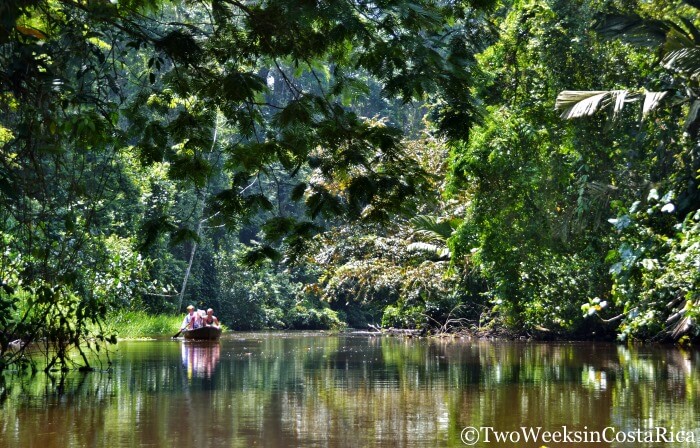
Though less common, another way to explore the canals is by renting a kayak or canoe and going on your own. We did this on one of our visits since we’ve taken a lot of tours in Costa Rica and are getting good at spotting wildlife.
For most people, though, hiring a good guide will add an incredible amount of value to the experience. The guides are locals who are extremely knowledgeable about the wildlife and know where to look so that you see many different species.
Land Trails
In addition to the canals, the park has a land trail near the ranger station right in town. If you can only do one tour, go for the canals, but if you have more time, the land trail is worth a visit.
This path is normally a loop, but sometimes parts of it close due to mud. During one of our visits, it was a nice long L-shaped trail that ran from one side of the peninsula straight across to the other then down a long stretch of beach. It took us about 3 hours to hike to the end and back.
Tip: A lot of people we talked to said that they didn’t see much wildlife along the trail, but luckily that wasn’t the case for us. Here are some tips to keep in mind when looking for wildlife. First, remember that animals are often hiding right in the trees above you. Unless they move, you’ll probably miss them because only rarely are they in plain sight near the trail. Second, keep your eyes glued to the canopy and walk slowly. If you see the trees move at all, keep looking because there’s probably a monkey or bird nearby.
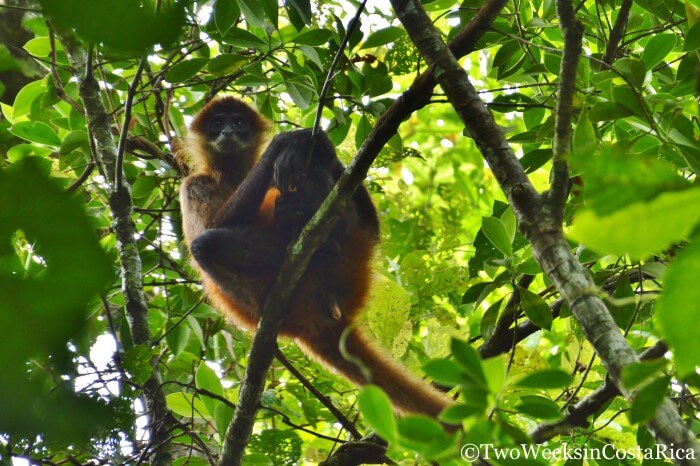
The main part of the trail near the ranger station is known for getting extremely muddy. If it has been raining lately, which is often is in Tortuguero, rent a pair of rubber boots from one of the vendors outside the park. The boots aren’t the most comfortable, but if you don’t wear them, you might find yourself covered in mud up to your knees. Be sure to bring some tall socks if you’re planning on a longer hike as the boots can get quite abrasive after a while.
Beaches & Turtle Tours
One of the most magical activities in Tortuguero National Park is a nesting turtle tour.
Four kinds of sea turtles come to the park’s gray sand beaches to lay their eggs. Green turtles have the biggest population by far and are the easiest to see. Visit during July to October to witness a nesting event.
If you’re lucky, you can also spot leatherback turtles between March and May. These gigantic creatures are extremely endangered so much more difficult to see, but if you can catch them, it’s a mystical experience.
Turtle watching tours happen at night along the beach. Tours range from $30 through small operators to $60 through lodges.
For lots more information on night turtle tours in Tortuguero, read our post about our experience, Tortuguero Sea Turtle Nesting Tour.
What You’ll See
Tortuguero has an amazing diversity of wildlife thanks to all the different kinds of habitat. On both the land trails and along the mangroves in the canals, you’re very likely to see several different types of monkeys. Howler monkeys, white-faced capuchin monkeys, and best of all, the more rare spider monkey can all be seen in the park.
In the canals, you can also see some unique wildlife not found in many places in Costa Rica. Freshwater turtles, caiman and crocodiles, lizards like green basilisks and iguanas, and many species of birds can all be spotted by paddling along the brackish canals.
Bird enthusiasts will want to have their cameras and binoculars handy for the array of interesting feathered friends. On one of our visits, we saw an impressive 18 species in just one day, including an Anhinga, Great Curassow, Tiger Heron, Sungrebe, and this beautiful Green Heron.
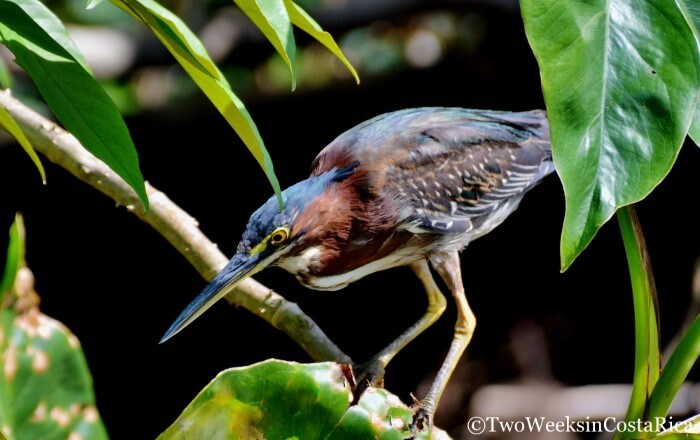
Planning Your Visit to Tortuguero National Park
Cost
Visitors: $15/adult, $5/children ages 2-12.
Citizens and Residents: ₡1,000/adult, ₡500/children ages 2-12.
Allows self-guided access to the canals and land trail; guided tours are additional.
Purchasing Tickets
Tickets for Tortuguero National Park must be purchased in advance through the SINAC government website.
First, you’ll need to create an account. There is a button to change the language to English.
After logging in, click Buy on the left, then select Online Reservation.
Select Parque Nacional Tortuguero – Sector Canales.
Choose your date and time of visit (under Sector/Schedule).
Select the number of people, adults and children.
On the last page, you will need to fill in everyone’s full names and passport numbers, then enter your credit card information to pay.
Finally, a confirmation document will be emailed to you. Take a screenshot in case you don’t have cell phone service in Tortuguero.
At the ranger station, you’ll need to show your confirmation.
Park Hours
The park is open every day, including holidays, from 6:00 a.m. – 4:00 p.m.
What to Wear/Bring
- Long, lightweight pants and repellent to protect against the many biting insects. Read our Packing post for specific repellent recommendations.
- If you’re taking one of the smaller boats or a kayak, you will want a dry bag to protect your phone or camera from getting wet.
- A hat and sunscreen.
- Plenty of water as Tortuguero is often hot and steamy.
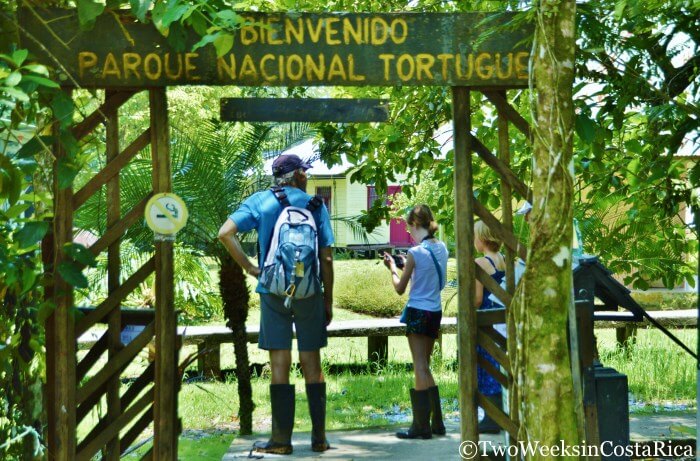
More National Parks on Costa Rica’s Caribbean Coast
Heading to the southern Caribbean coast after Tortuguero? Be sure to check out these national parks:
Cahuita National Park – Offers more excellent wildlife viewing (especially sloths and snakes). Has a large offshore reef for snorkeling.
Gandoca-Manzanillo National Refuge – Wild, remote rainforest near Puerto Viejo with endemic wildlife you won’t find anywhere else. This reserve also encompasses ocean and has some gorgeous coastal views.
Conclusion
If you’re visiting Costa Rica to see wildlife, be sure to add Tortuguero National Park to your trip itinerary. Because Tortuguero is slightly hard to get to, it took us several years to finally make it there, but we’re so glad we did. Not only is the town itself quaint and charming, but the wildlife you’ll encounter is spectacular. It’s well worth a visit.
Have a question about visiting Tortuguero National Park? Ask us below.
Want more information to help plan your trip? Check out these articles:
Getting to Tortuguero: Takes the mystery out of getting to this remote village. Info on arriving by plane and boat, driving directions, parking, and more.
Cerro Tortuguero: Hike and Viewpoint – Tortuguero National Park has another sector with scenic views of the town and surrounding rainforest. This entrance is also much cheaper.
Sea Turtle Conservancy: A quick stop at the Sea Turtle Conservancy will teach you about this organization’s important conservation work.
Corcovado National Park: Corcovado on the Osa Peninsula is another remote destination with amazing wildlife viewing.
Arenal Volcano National Park: Many people visiting Tortuguero make a stop in La Fortuna to see the famous Arenal Volcano.
Things to Do: Looking for more activities for your trip? Our Things to Do articles cover more wildlife tours as well as waterfalls, hanging bridges, zip lining, and cultural tours.



